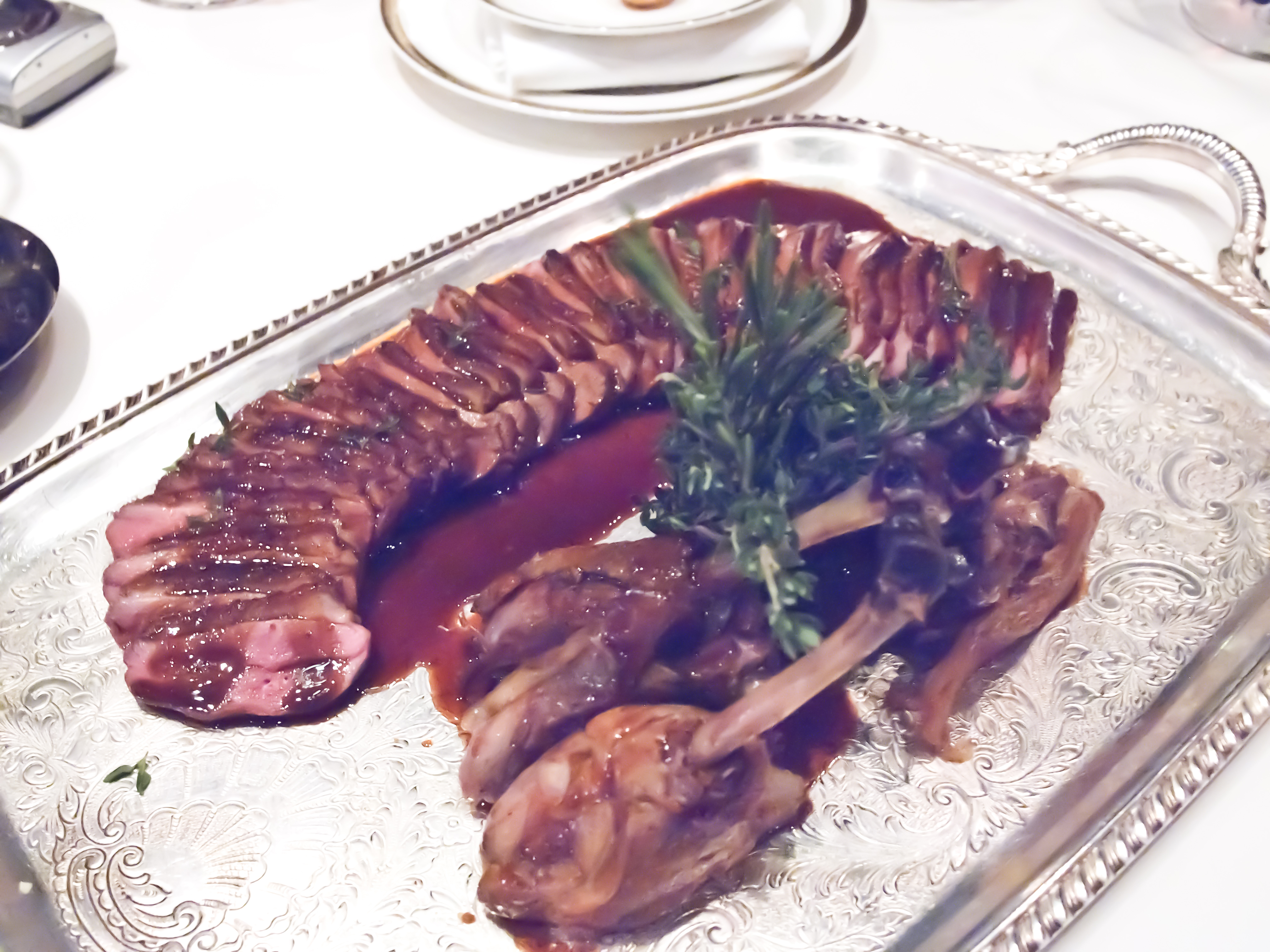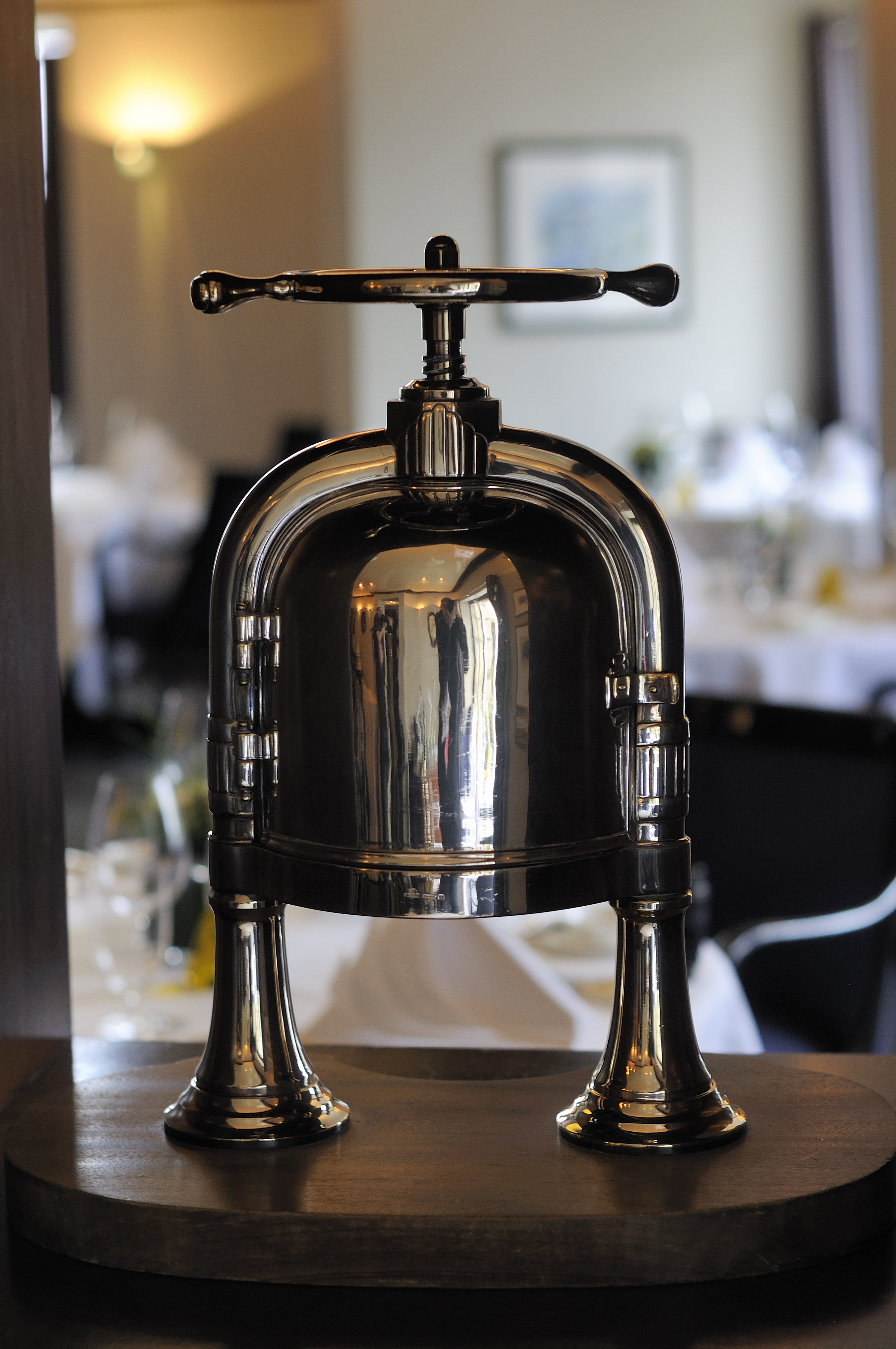Pressed Duck on:
[Wikipedia]
[Google]
[Amazon]

 Pressed duck (french: canard à la presse, caneton à la presse, canard à la rouennaise, caneton à la rouennaise or canard au sang) is a traditional French dish. The complex dish is a specialty of
Pressed duck (french: canard à la presse, caneton à la presse, canard à la rouennaise, caneton à la rouennaise or canard au sang) is a traditional French dish. The complex dish is a specialty of
 The remaining carcass (including other meat, bones, and skin) is then put in a specially-designed press, similar to a
The remaining carcass (including other meat, bones, and skin) is then put in a specially-designed press, similar to a

 Pressed duck (french: canard à la presse, caneton à la presse, canard à la rouennaise, caneton à la rouennaise or canard au sang) is a traditional French dish. The complex dish is a specialty of
Pressed duck (french: canard à la presse, caneton à la presse, canard à la rouennaise, caneton à la rouennaise or canard au sang) is a traditional French dish. The complex dish is a specialty of Rouen
Rouen (, ; or ) is a city on the River Seine in northern France. It is the prefecture of the region of Normandy and the department of Seine-Maritime. Formerly one of the largest and most prosperous cities of medieval Europe, the population ...
and its creation attributed to an innkeeper from the city of Duclair. Since the 19th century, it has also been a specialty of the Tour d'Argent restaurant in Paris
Paris () is the capital and most populous city of France, with an estimated population of 2,165,423 residents in 2019 in an area of more than 105 km² (41 sq mi), making it the 30th most densely populated city in the world in 2020. ...
where it is formally known as the ''Caneton Tour d'Argent'' (Tour d'Argent duckling). It consists of various parts of a duck
Duck is the common name for numerous species of waterfowl in the family Anatidae. Ducks are generally smaller and shorter-necked than swans and geese, which are members of the same family. Divided among several subfamilies, they are a fo ...
served in a sauce of its blood
Blood is a body fluid in the circulatory system of humans and other vertebrates that delivers necessary substances such as nutrients and oxygen to the cells, and transports metabolic waste products away from those same cells. Blood in th ...
and bone marrow
Bone marrow is a semi-solid tissue found within the spongy (also known as cancellous) portions of bones. In birds and mammals, bone marrow is the primary site of new blood cell production (or haematopoiesis). It is composed of hematopoieti ...
, which is extracted by way of a press. It has been considered "the height of elegance."
Preparation
First, a duck (preferably young and plump) isasphyxiated
Asphyxia or asphyxiation is a condition of deficient supply of oxygen to the body which arises from abnormal breathing. Asphyxia causes generalized hypoxia, which affects primarily the tissues and organs. There are many circumstances that can i ...
to retain the blood. The duck is then partially roasted
Roasting is a cooking method that uses dry heat where hot air covers the food, cooking it evenly on all sides with temperatures of at least from an open flame, oven, or other heat source. Roasting can enhance the flavor through caramelizati ...
. Its liver
The liver is a major organ only found in vertebrates which performs many essential biological functions such as detoxification of the organism, and the synthesis of proteins and biochemicals necessary for digestion and growth. In humans, it ...
is ground and seasoned, then the legs and breast are removed.
wine press
A winepress is a device used to extract juice from crushed grapes during wine making. There are a number of different styles of presses that are used by wine makers but their overall functionality is the same. Each style of press exerts contro ...
. Pressure is then applied to extract duck blood and other juices from the carcass. The extract is thickened and flavoured with the duck's liver, butter
Butter is a dairy product made from the fat and protein components of churned cream. It is a semi-solid emulsion at room temperature, consisting of approximately 80% butterfat. It is used at room temperature as a spread (food), spread, melted a ...
, and cognac
Cognac ( , also , ) is a variety of brandy named after the commune of Cognac, France. It is produced in the surrounding wine-growing region in the departments of Charente and Charente-Maritime.
Cognac production falls under French appellat ...
, and then combined with the breast to finish cooking.
Sauce
Other ingredients that may be added to the sauce includefoie gras
Foie gras (, ; ) is a specialty food product made of the liver of a duck or goose. According to French law, foie gras is defined as the liver of a duck or goose fattened by gavage (force feeding).
Foie gras is a popular and well-known delica ...
, port wine
Port wine (also known as vinho do Porto, , or simply port) is a Portuguese fortified wine produced in the Douro Valley of northern Portugal. It is typically a sweet red wine, often served with dessert, although it also comes in dry, sem ...
, Madeira wine
Madeira is a fortified wine made on the Portuguese Madeira Islands, off the coast of Africa. Madeira is produced in a variety of styles ranging from dry wines which can be consumed on their own, as an apéritif, to sweet wines usually consu ...
, and lemon
The lemon (''Citrus limon'') is a species of small evergreen trees in the flowering plant family Rutaceae, native to Asia, primarily Northeast India (Assam), Northern Myanmar or China.
The tree's ellipsoidal yellow fruit is used for culin ...
. The breast is sliced and served with the sauce in a first serving; the legs are grilled
Grilling is a form of cooking that involves dry heat applied to the surface of food, commonly from above, below or from the side. Grilling usually involves a significant amount of direct, radiant heat, and tends to be used for cooking meat a ...
and served as the next course
Course may refer to:
Directions or navigation
* Course (navigation), the path of travel
* Course (orienteering), a series of control points visited by orienteers during a competition, marked with red/white flags in the terrain, and corresponding ...
."Pressed Duck a la Tour d'Argent," in
See also
*List of duck dishes
In cooking and gastronomy, duck or duckling is the meat of several species of bird in the family Anatidae, found in both fresh and salt water. Duck is eaten in many cuisines around the world. It is a high-fat, high-protein meat rich in iron ...
* Rouennaise sauce
References
{{reflist French cuisine Duck dishes Norman cuisine